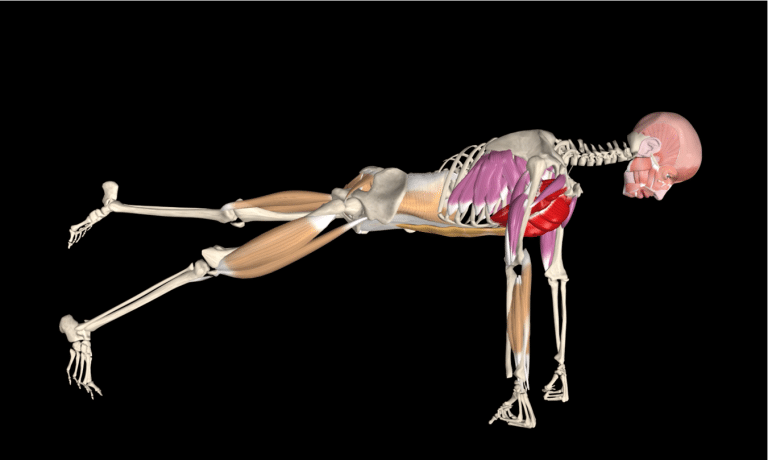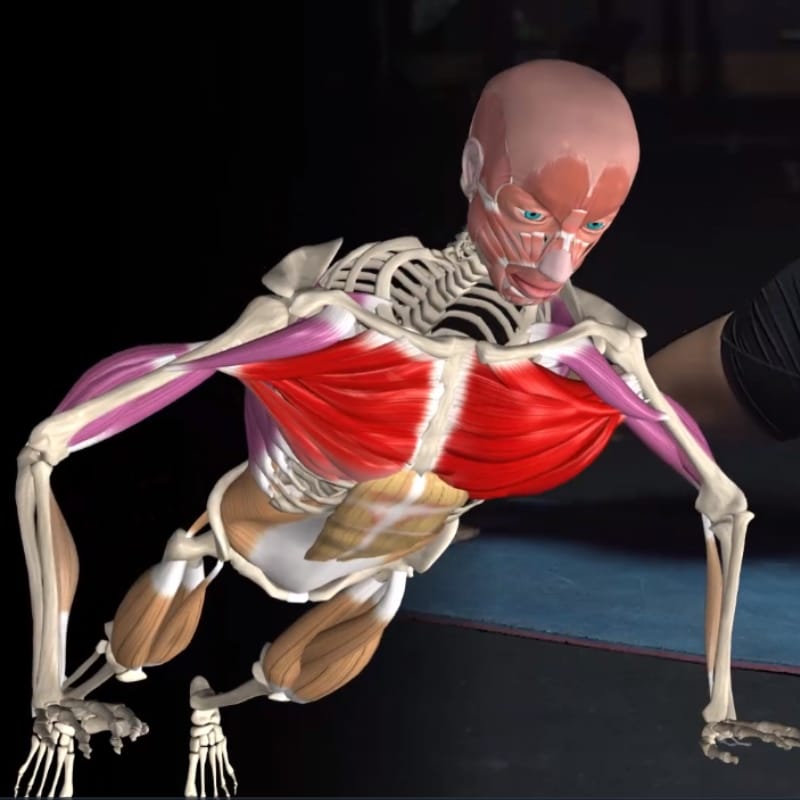The push-up is a strength exercise that activates the pecs and the core muscles to stabilize the spine and enable a neutral spine position throughout the exercise. But some push-up exercises will pump up your core more than others by changing the body’s direction, disconnecting a limb, working on an unstable surface, and more.
In this Muscle and Motion blog, we’ve collected three push-up exercises with extra core activation you should try in your next training session (whether it’s at the gym, at home, or anywhere else), as it is super important to diversify your workout sessions with different variations of your regular exercises.
Note: If your wrists start hurting in any push-up exercise, you could perform it with your hand on dumbbells or small parallettes on your fists so you’d be able to keep a neutral position of the wrists.
1 . Single-leg push-up
The second you lift one limb off the ground, your core activates immediately in order to stabilize your body and spine.
Let’s see how to make it happen:
- ➔ Get into a plank in one straight line from head to heel
- ➔ Lift one leg of the ground
- ➔ Bend your elbows into a push-up while maintaining a line from the elevated leg to the head
- ➔ Push back up and keep your leg elevated

Anatomical analysis of the single-leg push-up
The target muscle is the pectoralis major (performing horizontal adduction) and the core muscles that stabilize the body, mostly the transversus abdominis and the pelvic floor muscles, which maintain internal abdominal pressure. The muscles that assist in the movement are the anterior deltoid, triceps brachii, and serratus anterior.
2 . T push-up
This exercise adds two challenges to the regular push-up – A direction change that makes the side of the body activate and a disconnection of two limbs, the upper arm and upper leg, which no longer stay on the ground.
These are the steps to perform the T push-up:
- Get into a plank and perform one push-up.
- After returning to the plank, lift one hand off the ground, raise it straight up in the air, and place the upper foot on top of the lower foot.
- Make sure to keep your body vertical to the ground. Then, go back into the plank.

Anatomical analysis of the T push-up
The target muscle is the pectoralis major and core muscles, with an emphasis on the obliques and the erector spinae facing the ground. The sternocostal head is dominant in this position. All the muscles facing the floor stabilize the body.
In addition to the external oblique, all the muscles facing the floor direction stabilize the body. These include the gluteus medius, tensor fascia latae and spinal erectors.
3 . Dome-down BOSU push-up
Placing your limbs, arms or legs, on an unstable surface will get your core going instantly to keep your balance and your spine’s natural curves. A BOSU balance trainer will achieve this instability
How to perform a dome-down BOSU push-up:
- Place the BOSU with the soft part down
- Get into a plank position with your fingers facing out
- Brance your core muscles throughout the exercise

Anatomical analysis of the dome-down BOSU push-up
The target muscle is not only the pectoralis major but also the stabilizing muscles- the core muscles that are intensively active and serve as a “bridge” between the arms and legs. The synergists are the triceps brachii, anterior deltoid, and serratus anterior.

Common mistakes
Push-ups are one of the most popular exercises in strength training, which we do mainly to strengthen the chest and core muscles. But what happens when the chest muscles don’t have enough strength, or there’s a lack of awareness of the correct movement?
One of the most common mistakes is that the up and down movement is performed through addiction and abduction of the scapula instead of an elbow bend. That makes the serratus anterior the main muscle that abducts the scapula, the target muscle, and not the pectoral muscles as it should be.
So, what is the correct movement?
Bring the chest to the floor as you flex the elbows and maintain the spinal curves in a neutral position (same as in standing). In the picture, you can see the common mistake of straight arms and movement through the scapula. Above, in the upper animation, we see the correct form.
How do we solve the problem?
If you don’t have enough chest muscle strength, place your knees on the floor. It will reduce the load and enable you to perform the movement correctly. As you progress, you can then perform the exercise with straight legs. In both variations, be sure to maintain a straight back and neutral curves.
At Muscle and Motion, we believe that knowledge is power, and understanding the ‘why’ behind any exercise is absolutely essential for your long-term success.
Let the Strength Training App help you achieve your goals! Sign up for free.


